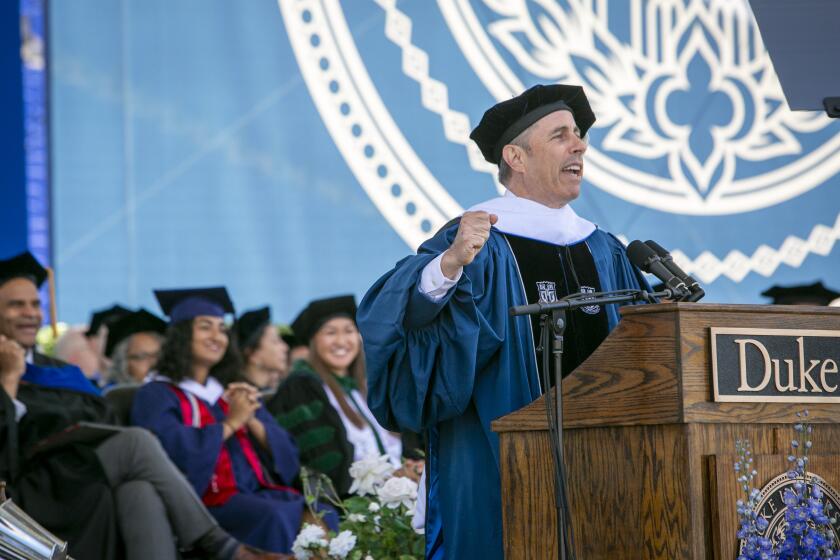2 ‘Night’ tales from the dark side
One is notable for being the only X-rated film to win an Oscar. The other marks the first starring role for an actor who would later change the face of American cinema. Both are playing the Los Angeles Film Festival this week as special retrospective screenings.
Jon Voight had appeared in a few films and was making a name for himself off-Broadway when he was cast as Joe Buck, a naive Texan turned New York street hustler who becomes unlikely friends with a low-life named Ratso Rizzo (Dustin Hoffman) in 1969’s “Midnight Cowboy.”
Despite an initial X rating from the MPAA, the film would go on to win critical raves and later the best picture Oscar. Academy Awards also went to director John Schlesinger and screenwriter Waldo Salt, who adapted James Leo Herlihy’s novel. Voight received an Oscar nomination; Hoffman, who earned his second Academy Award nomination, solidified his status as one of Hollywood’s young Turks.
Dennis Hopper had been kicking around Hollywood since the mid-1950s, notably as one of the gang members in the 1955 James Dean classic “Rebel Without a Cause.” He finally got his opportunity to headline his first film, 1961’s atmospheric love story “Night Tide,” an independent production directed by Curtis Harrington. Years before his “Easy Rider” would change how Hollywood makes and markets movies, Hopper played a sweetly naive sailor who falls in love with a mysterious young woman who works as a mermaid in an amusement park. Shot in black and white in Venice and Santa Monica, “Night Tide” also features a score by the legendary David Raksin (“Laura”).
The Los Angeles Film Festival is celebrating these two very different filmic meditations on love, longing and nocturnal desire. Voight will talk about “Midnight Cowboy” at the 40th-anniversary screening Thursday evening at the Billy Wilder Theater; two days later at the Wilder, the Academy Film Archive’s restoration of “Night Tide” will receive its L.A. premiere.
Freedom on the set
“John Schlesinger had a wonderful sense of humor,” Voight said recently about his memories of making “Midnight Cowboy.” “He was also very insecure partially because he was a perfectionist and he would never live up to his own standards, so he questioned himself continuously.”
The British director, said Voight, was nervous because he was working in the U.S. for the first time. “Yet he was perfect for the material. . . . He was foreign to New York, and everything in New York was amazing to him. . . . His background had been in documentaries for the BBC, so he was very interested in human behavior.”
Schlesinger also encouraged Voight and Hoffman to improvise. “We did a whole couple of days of improvisation with tape recorders,” he said. “It really helped to get our characters down.”
Salt incorporated some of their banter into the screenplay. But there is one bit of memorable dialogue that Voight and Hoffman totally improvised on camera.
“The scene is where Dusty and me are sitting in a little cafeteria . . . ,” recalls Voight. “Dusty said, ‘You can come back in another body.’ And I said, ‘Well, I hope I don’t come back in your body.’ Then he said, ‘You can come back as a dog or a president.’ And I said, ‘If I had a choice between a president and a dog, I would come back as the president. I ain’t that dumb.’ ”
A difficult process
The restoration of “Night Tide” was funded partly by Martin Scorsese’s Film Foundation and the Academy Film Archive, which had previously worked with Harrington, who died in 2007 at age 80, on restoring and preserving his experimental, avant-garde shorts from the 1940s and ‘50s.
The academy knew time was of the essence with “Night Tide” because it had learned several years before that the negative was not in good shape.
Though there were few scratches on the original, it was suffering from what is called “acetate deterioration” in restoration circles.
“When you touched it, it felt weird,” said the academy archive’s Mark Toscano, who oversaw the restoration. “It was shrunk and warped.”
Normally in the restoration process, the negative is fed through a printer so a new print can be made. But in the case of “Night Tide,” said Toscano, “it was so shrunken we couldn’t print the negative in order to make that first print.”
He credits Dave Tucker at Triage Motion Picture Services in Hollywood for figuring out a way to get the negative through the scanner. “He really is the hero of the film,” said Toscano.
--
More to Read
Only good movies
Get the Indie Focus newsletter, Mark Olsen's weekly guide to the world of cinema.
You may occasionally receive promotional content from the Los Angeles Times.







